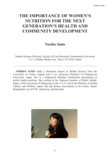The Importance of Women’s Nutrition for the Next Generation’s Health and Community Development

Malnutrition in the womb and between birth and age 2 years has largely irreversible consequences. Maternal undernutrition is a common cause of poor fetal growth and a low birthweight (LBW). A LBW baby whose birth weight is below 2500 grams has not achieved her full growth in the womb and is undernourished from birth. If her malnutrition is not treated and she does not attain 'catch-up growth' during her childhood, she becomes an underweight woman who is at increased risk of having a LBW baby or losing the baby in the fetal or neonatal periods. Malnourished children may enroll late in school, and therefore get less education, and cannot do heavy physical work for long periods, and therefore get less income.
A child starts life as a single cell in the womb. The cell absorbs nutrients; it grows and divides into two cells. Each new cell absorbs nutrients to grow larger and divide again, until there are millions of cells which form different tissues such as neuron and brain. If enough nutrients are not available, these organs are not fully developed and mental function is damaged. Children who were malnourished in the first 1000 days cannot study well and so may get poor grades at school or drop out. It affects children's ability to make a living and realize their full potential for a full and healthy life.
If the fetus is undernourished, it adapts to this lack of nutrients by permanently modifying its structure and metabolism in order to survive. This is called 'nutritional programming.' The most obvious mechanism by which this adaptive programming could have an effect is through altering normal tissue and organ development. Exposure to low-protein diet during gestation leads to kidneys with fewer nephrons exhibiting symptoms of primary hypertension. Type 2 diabetes characterized by impaired insulin action and altered insulin secretion is a common postnatal phenotype seen as a result of nutritional programming.
Undernourished adults who have a lack of physical strength and stamina get low incomes. Physically and mentally disabled people due to micronutrient deficiencies will be a burden on their family. And today, most developing countries face a growing number of patients with non- communicable diseases (NCDs). NCDs are now a major development issue affecting health, well- being, income, and productivity. They cause premature death and disability-often of a main carer or wage earner at household level and loss of working population at community level. The coexistence of undernutrition or micronutrient deficiencies and signs of overnutrition is called 'the double burden of malnutrition.' Today, not only developing countries but also developed countries have to tackle both undernutrition and overnutrition at the same time.
| Alternative title | 次世代の健康と地域の発展のための女性の栄養の重要性 |
|---|---|
| Date of issued | |
| Creator | Noriko Sudo |
| Subject | the first 1000 days nutritional programming the double burden of malnutrition intra-household food distribution nutritional education |
| Publisher | Japan International Research Center for Agricultural Sciences |
| Available Online | |
| NII resource type vocabulary | Conference Paper |
| Issue | 2017 |
| spage | 27 |
| epage | 32 |
